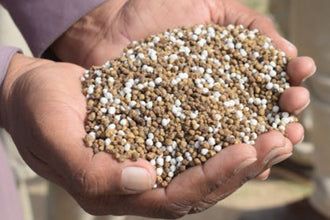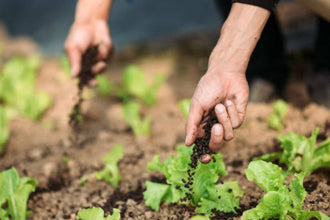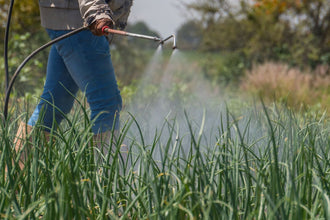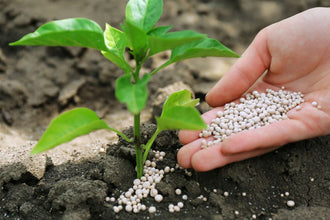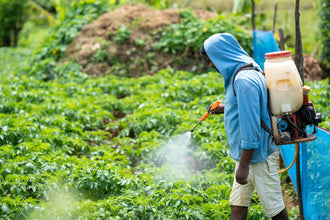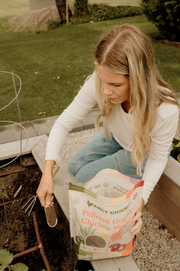
Liquid fertilizer gives you faster results and better control over how you feed your plants. Most gardeners love switching to liquid because they can see changes happening in just days instead of waiting weeks. You get to decide exactly when and how much nutrition your plants receive.
Regular fertilizer pellets need time to break down in your soil before plants can use them. Liquid fertilizer skips that waiting period. Your plants can start using the nutrients right away. This speed makes a huge difference if you're growing in containers or trying to fix a hungry-looking plant quickly.
You can apply liquid fertilizer two different ways. Pour it around the roots like you would water, or spray it right on the leaves. Both methods work great, and you can even do both at the same time. This flexibility gives you way more options than you get with regular granular fertilizer.
How Liquid Fertilizer Actually Works in Your Garden
Plants grab nutrients from liquid fertilizer much faster than from pellets or granules. The nutrients are already dissolved and ready to go. Your plants don't have to wait for soil microbes to break anything down first.
When you water liquid fertilizer into the soil, plant roots soak it up along with the water. The roots have tiny hairs that act like straws, pulling in both water and nutrients at the same time. This happens pretty much instantly if your soil drains well and isn't bone dry.
You can also spray liquid fertilizer right on plant leaves. The leaves actually absorb nutrients through their surface. This leaf feeding works really well for micronutrients that plants need but sometimes can't get from the soil easily.
Why Root Feeding Works So Well
Your soil needs to have some moisture for root feeding to work properly. Dry soil won't move the liquid fertilizer around where roots can find it. But soggy soil isn't good either because roots need oxygen too.
Temperature makes a big difference in how fast roots work. Warm soil gets roots moving and absorbing nutrients quickly. Cold soil slows everything down. That's why spring feeding works better once the ground warms up a bit.
Loose, well-draining soil lets liquid fertilizer reach more root areas. Heavy clay soil can block the nutrients from getting around. If you have clay soil, you might want to water more slowly so the liquid fertilizer has time to soak in instead of running off.
Getting Great Results from Leaf Spraying
Spraying liquid fertilizer on leaves works best early in the morning. The tiny pores on leaves open wider when it's cooler, and the fertilizer won't evaporate as fast. Hot afternoon sun can actually burn leaves if you spray fertilizer on them.
Leaf feeding helps when your soil has problems that block nutrient absorption. Maybe your soil pH is off, or it has too much clay. Spraying the leaves gets nutrition to your plants even when the soil isn't cooperating.
The downside is that leaf spraying takes more work than root feeding. You need to cover all the leaves evenly, and you'll probably need to do it more often. But for fixing problems quickly or feeding micronutrients, leaf spraying really works.
Types of Liquid Fertilizer You Can Choose From
You'll find liquid fertilizer in several different forms when you go shopping. Each type has its own benefits depending on what you're growing and how you like to garden.
Synthetic liquid fertilizers give you exact nutrient amounts every time. The numbers on the package tell you exactly what your plants will get. These work great for container gardens and hydroponic systems where you need precise control.
Organic liquid fertilizers come from natural sources like fish, seaweed, or composted materials. They feed your soil microbes while feeding your plants. This helps build better soil over time, but the nutrient release can be less predictable.
Concentrated vs Ready-to-Use Products
Concentrated liquid fertilizer costs less per application, but you have to mix it with water first. You need to measure carefully because too much concentration can burn your plants. Most concentrates come with mixing charts for different plants and growth stages.
Ready-to-use liquid fertilizer costs more but saves time and reduces mistakes. You just grab the bottle and start feeding. These work well for small gardens or if you don't want to deal with measuring and mixing.
Special Purpose Liquid Fertilizer Options
Some liquid fertilizers target specific plant needs:
-
Bloom boosters have extra phosphorus to help plants make more flowers and fruits
-
Starter fertilizers focus on root development for new transplants
-
Growth formulas pack in nitrogen for leafy green growth
-
Micronutrient blends supply trace elements that plants need in tiny amounts
Smart Ways to Apply Liquid Fertilizer
How you apply liquid fertilizer makes a huge difference in your results. The right method depends on what you're growing and how much time you want to spend on plant care.
Soil drenching works great for established plants with good root systems. Mix your liquid fertilizer according to the directions and pour it around the base of each plant. Water afterward to help move the nutrients down to the roots.
For bigger areas, you might want to use a hose-end sprayer or watering can with a rose attachment. These tools help you cover more ground without spending all day mixing and pouring.
Getting the Timing Right
Most plants do better with regular, light feeding instead of occasional heavy doses. Weekly applications during growing season usually work better than monthly heavy feeding. Your plants can only absorb so much at once anyway.
Spring feeding should start light because plants are just waking up from winter. Cold soil and slow root activity mean plants can't handle heavy nutrition yet. Start with half-strength applications until you see active new growth.
Summer applications work best early in the morning before it gets hot. Plants under heat stress can't absorb nutrients well. If your area gets really hot, you might need to skip feeding during the worst heat waves.
Fall feeding should gradually decrease as plants prepare for winter. Stop heavy nitrogen feeding about 6 weeks before your first expected frost. Plants need time to toughen up for cold weather.
Storage Tips That Actually Matter
Keep liquid fertilizer concentrates in a cool, dry place away from sunlight. Heat and light can break down the nutrients over time. A garage or shed usually works fine as long as it doesn't get freezing cold.
Check expiration dates regularly. Liquid fertilizer doesn't go bad like milk, but the nutrients can become less effective over time. Organic liquid fertilizers usually don't last as long as synthetic ones.
Don't store mixed fertilizer for more than a day or two. Once you add water, bacteria can start growing. Mix only what you need for immediate use.
Liquid Fertilizer vs Regular Granular Fertilizer
Choosing between liquid fertilizer and granular products often comes down to your gardening style and what results you want to see.
Liquid fertilizer gives you immediate results and precise timing control. You can adjust the strength based on what your plants need right now. This works especially well for container gardening, houseplants, and fixing nutrient problems quickly.
Granular fertilizers release nutrients slowly over weeks or months. They work well for large areas like lawns where you don't want to be feeding constantly. But they take longer to show results and don't give you much flexibility in timing.
What Each Option Costs You
Liquid fertilizer usually costs more per application than granular. But you might need fewer total applications because plants absorb it more efficiently. The math gets complicated when you factor in your time and the results you get.
For large areas like lawns, granular fertilizer probably costs less overall. For containers, raised beds, or specialty plants, liquid fertilizer might actually save money because you waste less and get better results.
Which One Works Better for the Environment
Liquid fertilizer causes less runoff when you apply it correctly. The nutrients get absorbed quickly instead of washing away in the next rain. This helps keep fertilizer out of streams and groundwater.
Granular fertilizer can contribute to water pollution if you apply it right before heavy rain or if you use too much. But the slow release means less chance of shocking plants with too much nutrition at once.
Getting Better Results with Smart Techniques
A few simple tricks can make your liquid fertilizer work much better without costing you extra money.
Your water quality affects how well liquid fertilizer works. Really hard water can bind up nutrients so plants can't use them. If your water has lots of minerals, try using rainwater or filtered water for mixing fertilizer.
Soil pH also matters for nutrient absorption. Most plants absorb nutrients best when soil pH stays between 6.0 and 7.0. Test your soil pH and adjust it if needed before worrying about fertilizer problems.
Equipment That Makes Application Easier
Watering cans work great for small gardens and precise application. Get one with a fine rose attachment for even distribution. Clean it thoroughly between different fertilizer types.
Hose-end sprayers save time for larger areas but can be tricky to calibrate. Test the mixing ratio on a small area first. Look for models that let you adjust the concentration easily.
Pump sprayers give you excellent control for leaf feeding. The steady pressure ensures even coverage, and you can adjust the spray pattern for different sized plants.
Fixing Common Problems
Leaf burn means you used too much fertilizer or applied it during hot weather. Dilute your next application and switch to early morning timing. Most plants recover from minor burning without permanent damage.
Poor results might mean pH problems, stressed plants, or bad timing. Test your soil pH first. Make sure plants aren't dealing with drought, disease, or pest problems that prevent good nutrient uptake.
Salt buildup can happen in containers with repeated liquid fertilizer use. Flush containers monthly with plain water to wash out accumulated salts. This prevents root damage and keeps plants healthy.
Fancy Chicken Organic Pelletized Chicken Manure: Nature's Perfect Plant Food

Chicken manure has been a gardener's secret weapon for generations, and Fancy Chicken takes this time-tested approach to the next level. Their organic pelletized chicken manure delivers a balanced nutrient profile that plants absolutely love. Unlike synthetic alternatives, this natural fertilizer feeds both your plants and the beneficial microbes in your soil.
The pelletized form makes chicken manure much easier to handle than fresh or composted versions. Fancy Chicken's processing eliminates the strong odor and potential pathogens while concentrating the nutrients into convenient, uniform pellets. You get all the benefits of chicken manure without the mess or smell that keeps many gardeners away from this powerful organic option.
How Fancy Chicken Pellets Work in Your Garden
These organic pellets break down gradually in your soil, releasing nutrients over several weeks. This slow-release action means less risk of burning your plants while providing steady nutrition throughout the growing season. The organic matter also improves soil structure, helping sandy soils hold more water and clay soils drain better.
Key benefits of Fancy Chicken pelletized manure:
-
Higher nitrogen content than most other animal manures
-
Balanced NPK ratio that works for vegetables, flowers, and trees
-
Adds organic matter to build long-term soil health
-
Feeds beneficial soil microorganisms
-
Won't burn plants when used as directed
-
Easy to store and apply without unpleasant odors
Smart Application Methods for Maximum Results
Apply Fancy Chicken pellets just like you would any granular fertilizer. Work them into the top few inches of soil around existing plants, or mix them into planting beds before seeding. For established gardens, scatter the pellets and water them in thoroughly.
Application timing that works:
-
Early spring for perennials and established beds
-
At planting time for vegetables and annuals
-
Mid-season as a boost for heavy feeders like tomatoes
-
Fall application for spring bulbs and perennial preparation
The pellets need moisture to activate, so apply them before rain or plan to water afterward. Most gardeners find that one application lasts 6-8 weeks, making this an efficient choice for busy schedules.
Getting the Best Results from Your Investment
Start with the recommended rate on the package and adjust based on your plants' response. Vegetables and annual flowers usually need more frequent applications than established perennials or trees. Container plants benefit from lighter, more frequent feeding since nutrients wash out with regular watering.
Store your Fancy Chicken pellets in a dry location to prevent them from breaking down prematurely. The pelletized form stays stable for months when kept dry, making it easy to buy in bulk during sales. Unlike liquid fertilizers, you don't need to worry about expiration dates or mixing ratios - just apply and water in.
This organic approach builds soil health over time while feeding your plants. Most gardeners notice improved soil texture and plant vigor after a full season of using Fancy Chicken pelletized chicken manure alongside their regular garden care routine.
Transform Your Garden with Smarter Plant Nutrition
Liquid fertilizer can completely change how your garden performs. You get faster results, better control, and the satisfaction of seeing plants respond quickly to your care. Whether you grow vegetables, flowers, or maintain container gardens, liquid fertilizer gives you tools that regular fertilizer just can't match.
Start with one section of your garden to test how liquid fertilizer works for you. Most gardeners find that once they see the results, they never want to go back to waiting weeks for granular fertilizer to kick in. Your plants will thank you with faster growth, better color, and improved overall health.




